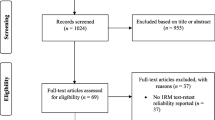Abstract
Objective
The objective of this study was to evaluate the prediction of ambulation in adults with myelomeningocele from muscle strength testing and ambulation in early life.
Materials and methods
Fifty-two myelomeningocele (MMC) individuals at the age 18–37 years at follow-up were studied. Information on muscle strength and ambulatory function in early life was retrieved from medical records. The motor levels determined by the muscle strength were used to predict ambulatory function later in life. At follow-up, a clinical examination was performed.
Results
Of 20 MMC individuals assessed with muscle strength within the first year of life, 7 achieved the predicted ambulatory function, 6 had a better, and 7 a poorer function. Of 32 individuals with known muscle strength at the age of 5–8 years, 10 had function as predicted, 5 a better ambulatory function, and 17 had a poorer ambulation in adult life than predicted. Good strength in quadriceps muscles gave significant better prospect for adult walking. Of the 52 participants, 41 retained their ambulation status from 5–8 years of age.
Conclusion
For MMC individuals with motor levels L3–L5, adult ambulatory function cannot be determined from muscle strength in early life, while it to some extend can be predicted for motor levels at or above L2 and at or below S1. The majority of the participants who at the age 5–8 years were community walkers without walking aid kept that function.
Similar content being viewed by others
References
Asher M, Olson J (1983) Factors affecting the ambulatory status of patients with spina bifida cystica. J Bone Joint Surg Am 65-A:350–356
Bartonek Å, Saraste H (2001) Factors influencing ambulation in myelomeningocele: a cross-sectional study. Dev Med Child Neurol 43:253–260
Brezner A, Kay B (1999) Spinal cord ultrasonography in children with myelomeningocele. Dev Med Child Neurol 41:450–455
Daniels L, Worthingham C (1980) Muscle testing, techniques of manual examination, 3rd edn. Saunders, Philadelphia
Findley TW, Agre JC, Halbeck RV, Schmalz R, Birkebak RB, McNally MC (1987) Ambulation in the adolescent with myelomeningocele I: early childhood predictors. Arch Phys Med Rehabil 68:518–522
Geiger R, Strasak A, Treml B, Gasser K, Kleinsasser A, Fischer V, Geiger H, Loeckinger A, Stein J (2007) Six-minute walk test in children and adolescents. J Pediatr 150:395–399 399.e1–2
Hawran S, Biering-Sørensen F (1996) The use of long leg callipers for paraplegic patients: a follow-up study of patients discharged 1973–1982. Spinal Cord 34:666–668
Hoffer MM, Feiwell E, Perry R, Perry J, Bonnet C (1973) Functional ambulation in patients with myelomeningocele. J Bone Joint Surg Am 55-A:137–148
Iborra J, Pagès E, Cuxart A (1999) Neurological abnormalities, major orthopaedic deformities and ambulation analysis in a myelomeningocele population in Catalonia (Spain). Spinal Cord 37:351–357
Jansen J, Taudorf K, Pedersen H, Jensen K, Seitzberg Aa, Smith T (1991) Upper extremity function in spina bifida. Child’s Nerv Syst 7:67–71
Keith RA, Granger CV, Hamilton BB, Sherwin FS (1987) The functional independence measure: a new tool for rehabilitation. In: Eisenberg MG (ed) Advances in clinical rehabilitation. Springer, Berlin, pp 6–18
Mazur JM, Shurtleff D, Menelaus M, Colliver J (1989) Orthopaedic management of high-level spina bifida. J Bone Joint Surg Am 71-A:56–61
McDonald CM, Jaffe KM, Shurtleff DB (1986) Assessment of muscle strength in children with myelomeningocele: accuracy and stability of measurements over time. Arch Phys Med Rehabil 67:855–861
McDonald CM, Jaffe KM, Mosca VS, Shurtleff DB (1991) Ambulatory outcome of children with myelomeningocele; effect of lower-extremity muscle strength. Dev Med Child Neurol 33:482–490
Murdoch A, Young DG (1979) How much value is muscle charting. Z. Kinderchir 28:387–392
Norrlin S, Strinnholm M, Carlsson M, Dahl M (2003) Factors of significance for mobility in children with myelomeningocele. Acta paediatr 92:204–210
Oi S, Yamada H, Matsumoto S (1990) Tethered cord syndrome versus low-placed conus medullaris in an overdistended spinal cord following initial repair for myelodysplasia. Childs Nerv Syst 6:264–269
Phuong LK, Schoeberl KA, Raffel C (2002) Natural history of tethered cord in patients with myelomeningocele. Neurosurgery 50:989–993
Rendeli C, Salvaggio E, Sciascia Cannizzaro G, Bianchi E, Caldarelli M, Guzzetta F (2002) Does locomotion improve the cognitive profile of children with myelomeningocele. Child’s Nerv Syst 18:231–234
Samuelsson L, Skoog M (1988) Ambulation in patients with myelomeningocel: a multivariate statistical analysis. J Pediatr Orthop 8:569–575
Schopler SA, Menelaus M (1987) Significance of the strength of the quadriceps muscles in children with myelomeningocele. J Pediatr Orthop 7:507–512
Sharrard WJ W (1964) The segmental innervation of the lower limb muscles in man. Annals Royal Col Surg 35:106–122
Sharrard WJW (1972) 4. Neuromotor evaluation of the newborn. In: American Academy of Orthopaedic Surgerons: Symposium on Myelomeningocele, Hartford, Connecticut November 1970. Mosby, Saint Louis, pp 26–31
Tamaki N, Shirataki K, Kojima N, Shouse Y, Matsumoto S (1988) Tethered cord syndrome of delayed onset following repair of myelomeningocele. J Neurosurg 69:393–398
Acknowledgments
We wish to thank PTU, The Association for Polio, Traffic and Accident Victims, The Association of Danish Physiotherapists Research Foundation, and Britta Holles Foundation for financial support. In addition, we like to thank Lise Stenlund and Lisbeth Nielsen for their practical assistance.
Author information
Authors and Affiliations
Corresponding author
Rights and permissions
About this article
Cite this article
Seitzberg, A., Lind, M. & Biering-Sørensen, F. Ambulation in adults with myelomeningocele. Is it possible to predict the level of ambulation in early life?. Childs Nerv Syst 24, 231–237 (2008). https://doi.org/10.1007/s00381-007-0450-2
Received:
Published:
Issue Date:
DOI: https://doi.org/10.1007/s00381-007-0450-2




